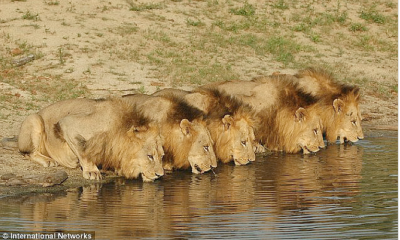|

Too many lions drinking water during a drought?
A factually questionable article in the UK Telegraph newspaper recently reported that the Bubye Valley “Conservancy” would have to “cull” 200 lions. The reason quoted was a persistent drought in the area, but associations have now also been made that the backlash against trophy hunting of lions after Cecil was also responsible. After all, Bubye was losing revenue with fewer trophy hunters now coming to Zimbabwe? But the Cecil Factor has nothing to do with it.
Let’s just restore some sense here.
First, Bubye is far from a “conservancy”. The area in the south of Zimbabwe is a fenced privately owned reserve. Investors include wealthy Arabs, wealthy white Zimbabweans, and doubtless a number of well-connected ZANU-PF members. The Bubye reserve was established after a cattle farming company lost interest in the land after a massive drought. All wildlife now behind fences in Bubye had to be bought and introduced, and Bubye decided the best business plan was to establish trophy hunting to make their commercial profits (a tourism venture failed). These days, the fenced area is heavily managed – providing borehole water to wildlife for example – but apparently there has been little positive return on investments since the Bubye Valley consortium was formed.
Second, 19 lions were purposely bought and introduced into the fenced area in 1999. It is alleged that some “wild” lions also came into the area after the fences were erected. Lion trophy hunting now forms a “mainstay” of trophy hunting profits accumulating to Bubye, though many other species are also on the hunting menu. The fenced lions do not live in any “natural” environment, and are there to be shot.
Third, Oxford University decided to establish a research programme on the Bubye ranch. Supposedly, Bubye provided a unique opportunity to study African lions within a trophy hunting area. Lion population dynamics were going to be monitored and modelled to assess sustainable trophy hunting. Lion trophy hunting success on Bubye is close to 100%. In 2012, a quota of 12 lions was issued and 12 lions were killed. Of course! These lions live behind a 2.1 metre fence! One of those involved in the Bubye lion research programme – Paul Trethowan – is now writing up his PhD Thesis at Oxford. Paul is already on record for signing a letter to the US Fish and Wildlife Service urging them NOT to list lions under their Endangered Species Act, and Mr Trethowan is cited by the Safari Club International, the Dallas Safari Club, and Conservation Force as an ally in the continuation campaign for lion trophy hunting. Bubye is a recipient of funding from both SCI and the DSC. In fact, Bubye offered a “raffle” lion trophy hunt to be drawn at the recent DSC convention – 1,500 tickets to be sold at $100 each – and a percentage was to go to the lion research. The raffle was later withdrawn – Oxford said they had no knowledge of this raffle to raise research funds, and the Bubye administration said it was only an initiative by one of their contracted trophy hunting operators.
Fourth, Bubye is now again in the news because they supposedly said they would have to cull 200 lions in their fenced reserve because of the “Cecil Factor”. Bubye actually said nothing of the sort, and this culling possibility was placed on hold at their board meeting in 2015.
Bubye does admit that well over 500 lions now inhabit their fenced area. Bubye intentionally allowed lions to breed because they felt that would bring trophy hunters in droves, and larger numbers of lions would afford them more quota. The supposed Bubye “culling” made hay in the media and in hunting circles.
All nonsense, as Cecil is not in any way connected with the supposed lion “cull”. Cecil was killed in July 2015, and the USFWS finally decided on their lion listing in December 2015. No connection, as the USFWS was considering listing lions as far back as 2011. However, the USFWS has placed a moratorium on all further lion imports from Zimbabwe, and as US hunters were the mainstay of lion trophy hunting in Bubye, the game ranch is now feeling the “pinch”. What better way to advertise Bubye’s plight than to surreptitiously support rumours that now 200 lions would have to be “culled”?
A private fenced hunting reserve in Zimbabwe can hardly claim to play a role in wildlife conservation – and neither can any similar reserve in South Africa. These areas are stocked with animals that might to some extent be free-ranging (until they hit the fence) but the resident species are highly selected to meet trophy hunter preferences. It would be interesting for Bubye to publish the population numbers and the species that occur behind their fences. Are those in any way reflective of numbers and species that occur in a more “natural” nationally protected area?
At the end of the day, trophy hunting in Zimbabwe can hardly be said to be well-regulated or “sustainable”. For example, a recent publication by Oxford University indicated that about 2/3 of male lions in Zimbabwe’s Hwange National Park died un-natural premature deaths and one of the causative factors was trophy hunting. In comparison, only 6% of male lions in the Serengeti National Park in Tanzania suffered similar fates.
Bubye clearly needs a better business model than their current complete reliance on trophy hunting to make ends meet. And using the blunt instrument of threatening to cull lions is not going to win that game ranch many friends or sympathisers – except perhaps among trophy hunters?
Picture credit: International Networks
|




